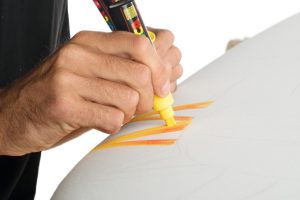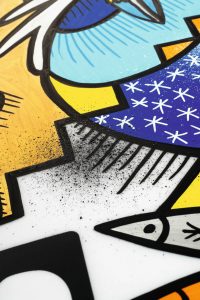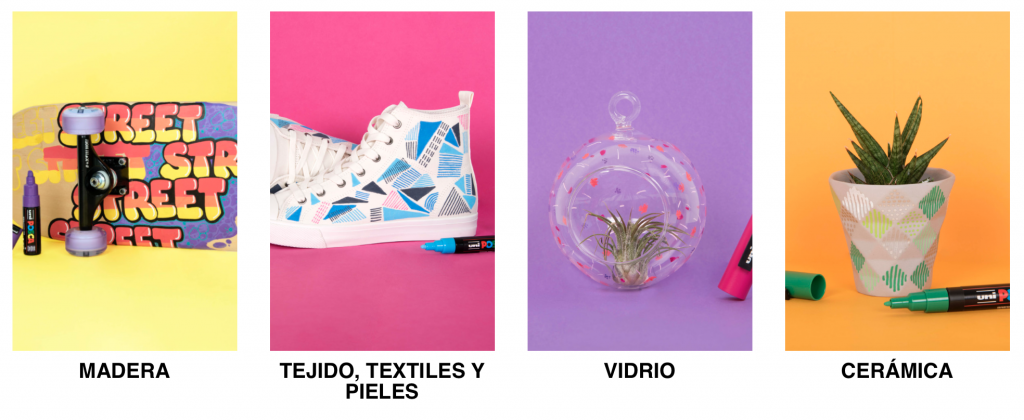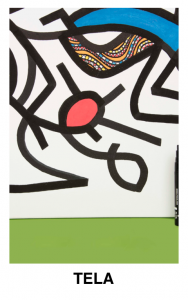Today we talk to you about Posca markers and all the materials you can use them on. A range of 59 colors, 8 metallic, 6 phosphorescent and 8 glitter.
There are 8 different types of tips and 5 shapes: brush tip, calibrated tip, conical tip, beveled tip and rectangular tip.
Wood: On treated or varnished wood, it is recommended to polish with sandpaper before starting work with POSCA. In the case of recovered or recycled wood, it is advisable to clean it first with water and a soft sponge and let it dry.
Fixation: Once the work is finished and dry, apply 2 coats of water-based spray varnish. Spray about 30 cm from the support with slow, circular movements. The varnish can be matte or glossy depending on the desired finish.
Fabrics, textiles and leathers: Before working on a fabric, wash it to remove industrial primer if it is new or possible dirt if it has been used. For leather-like skins, wipe with a damp cloth and allow to dry. For suede or suede, gently brush with a soft bristle brush.
POSCA are miscible and superimposable when applied to textiles or leather and are always better absorbed by natural materials. Drying times and the number of coats necessary to obtain a uniform result are variable and can be seen visually.
Fixation: Once the creation is finished and dried, you can iron it from the back, without steam. Be careful with the temperature of the iron according to the material used. You can place a piece of kitchen paper between the iron and the material to better protect it. If the material used cannot be ironed, you can fix the creation using a hair dryer, keeping it about 30 cm from the support.
Glass: Clean the stand with a cloth, make sure the surface is not wet or greasy before starting. To correct an error, simply wipe the concerned area with a damp cloth.
Fixation: To fix the creation permanently (thus eliminating its food use), apply two coats of water-based spray varnish. Spray about 30 cm from the support with slow, circular movements. The varnish can be matte or glossy depending on the desired finish.
Ceramics: Wipe the support with a cloth and make sure it is dry before starting work. POSCA are miscible and superimposable applied to ceramics. If the ceramic is treated, the POSCA paint will take longer to dry, so it is recommended to paint in strokes. For raw ceramics, several layers will be needed to complete the work since, being more porous, it will absorb more paint.
Fixation: Once finished and dry, you can fix the creation. In the case of treated ceramics, fix the creation for non-food use with a water spray, spraying at 30 cm with small circular movements. In the case of raw ceramics, bake the piece: first slow firing up to 220° and then stop the oven and lower the temperature so that the object comes out cold. For porcelain, proceed in the same way, but at a temperature of 160° for 45 minutes maximum.
Paper/Cardboard: No special preparation is needed to use POSCA on paper. On cardboard, be sure to remove any dust from the surface first.
Fixation: The application of POSCA on paper or cardboard does not require particular fixation. However, to extend its conservation, you can apply either a matte or gloss varnish.
Plastic: No special preparation is needed to use POSCA on plastic. However, we recommend that you dust and degrease the surface if necessary. The smoother the surface of the plastic, the less porous it will be, so the drying time will be longer and you will have to wait longer before touching the creation. .
Fixation: Once the work is finished and dry, apply 2 coats of water-based spray varnish. Spray about 30 cm from the support with slow, circular movements.
Metals: Wipe the stand with a cloth and make sure the surface is not wet or greasy before you start creating. If the metal used is varnished, the POSCA drying time will be longer.
Fixation: Once the work is finished and dry, we recommend applying between two and three coats of water-based spray varnish, especially in case of outdoor exposure.
Minerals: Clean the support with a cloth and make sure it is dry before starting work. Minerals are naturally porous materials and absorb paint more or less depending on their nature.
Fixation: Once the work is finished and dry, apply two coats of water-based varnish.
Fabric: Make sure the canvas is well prepared before beginning the creation.
With POSCA you can apply all the techniques and all the effects on canvas.
Fixation: The application of POSCA on canvas does not require particular fixation, but, to extend its conservation, you can apply a water-based varnish.
Some effects you can do with POSCA:
WATERCOLORABLE
POSCA paint is watercolorable: it can be diluted to obtain a gradient effect. The operation is carried out before drying: with a brush previously soaked in water, work the paint directly on the material until the desired finish is obtained.
 MISCIBLE
MISCIBLE
While the paint is wet, the colors can be mixed on the support with the tip or a brush and thus create infinite shades.
If the tip is stained, clean it and reload the marker to restore the original color.
SUPERIMPOSABLE
POSCA paint, dense and opaque, is ideal for overlays.
Dark colors can be applied over light colors and vice versa. And, thanks to its quick drying, overlays can be easily made without overflow.

SOUFFLE
The soufflé technique allows you to obtain a gradient effect typical of street art.
Simply blow hard (but carefully!) on the tip of the POSCA previously soaked in paint. This technique works especially with thick tips: PC-5M, PC-7M, PC-8K and PC-17K.
We hope you like them and they help you inspire and create!




 MISCIBLE
MISCIBLE



